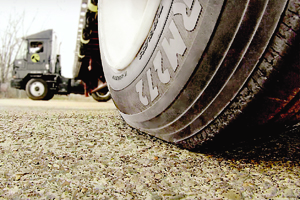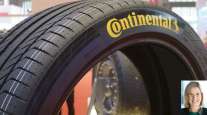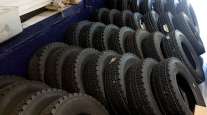Manufacturers Say Fleet Testing Essential for Developing Improved Truck Tires

This story appears in the April 25 print edition of Transport Topics.
Many of tomorrow’s truck tires are actually on the road today. They are being tested by private fleets hauling food and picking up trash. They are being run on test tracks in South Carolina and Texas. They are being driven over snow-covered roads in northern Canada and on logging trails in Central America.
Perhaps more than any other truck component, tires are developed with the direct involvement of fleet customers with manufacturers using data from test fleets — and sometimes their own — to evaluate the performance of products before they are made available for sale.
“Testing with customers is essential in tire development,” said Paul Crehan, director of product marketing for Michelin Truck Tires in Greenville, South Carolina. “It provides real-world information on the influences affecting performance, such as drivers, weather, roads, variations in maintenance practices and determines how the tire will ultimately perform under these influences.”
While manufacturers also use laboratory analysis and dynomometers to test new designs and materials, tire executives say it is critical to know how tires perform under real-world conditions.
“Road conditions can only be approximated in the lab,” said Gary Schroeder, director of commercial vehicle and OEM sales for Cooper Tire & Rubber Co. in Findlay, Ohio. “Our engineers use a combination of laboratory, third-party and on-vehicle tests to generate performance data during the course of the development process. Data is then compared to see how our tires stack up to the competition.”
Cooper owns and maintains its own fleet of trucks and trailers. The company recently built a test facility near its corporate headquarters in Findlay to replicate road conditions in connection with development of a new tire for drop-deck trailers.
Reuben DeBolt, a technical service manager who helped design the new test site for Cooper, said the company found it difficult to test its new trailer tire in a way that would simulate the conditions faced by fleets in the field.
“Tires in this application are arguably the most abused of any in the trucking industry,” DeBolt said. “We tried several different test protocols at commercially available test sites, but we were not able to replicate the conditions we had seen on some tires returned from the field. We had to create our own.”
The company developed its own testing protocol and built a small test facility where it could evaluate the tires on a variety of road surfaces.
“We poured three concrete test pads and treated the pads to simulate three different road surfaces,” DeBolt said. “We then dragged the tires, under full loads, across each of the test surfaces to simulate the dragging they would experience out in the field maneuvering in tight quarters.
“Think of running your fingernails down a chalkboard,” he said. That’s what we were doing to our test tires and those of our competitors.”
The result was RM272, a tire with a four-belt steel casing, a slightly rounded tread footprint and a reinforced shoulder that the company said is capable of being used for up to six years and two retreads.
Cooper’s Schroeder said the company uses a combination of its own fleet and customer fleets to test new products.
“Cooper’s fleet [is] an effective test bed for performance characteristics, such as fuel economy, durability, traction, miles to removal and casing retreadability,” he said. “We also evaluate tires on other commercial fleets to see how our tires perform in a variety of applications and obtain a more well-rounded assessment of performance.”
Other tire manufacturers follow a similar pattern.
“We have several fleets that help test our products, as well as our own test facilities around the world,” said Rick Phillips, vice president of sales for Yokohama Tire Corp. “Almost every commercial product that we currently have and future products that are still in development have all had input from our customers.”
As for Akron, Ohio-based Goodyear Tire & Rubber Co., the company “tests its truck tires in a wide range of ways and in a wide range of venues before these products enter the field,” said Brian Buckham, general manager of product marketing for Goodyear.
Goodyear uses in-house lab testing and evaluation by third-party testing companies, along with testing at its proving grounds in San Angelo, Texas, and on-road fleet evaluations.
“Fleet testing is particularly important as it generates a tremendous amount of real world data,” Buckham said.
Although it can take years to get results, tire executives said it is important to find fleets willing to test products under a variety of different conditions.
“We look for fleets who operate in the general geographic area the tire is designed for and who have good maintenance practices and good record keeping,” said Michelin’s Crehan. “Fleets who strive to improve their operations are ideal candidates for testing.”
None of the tire manufacturers interviewed for this story were willing to publicly identify fleets that are working with them to test products.
Michelin spokeswoman Mary Ann Kotlarich described a typical arrangement. “One of the fleets that did some Uniroyal testing was located in the Southwest and runs approximately 100 power units and 500 trailers in the region with fairly heavy loads,” she said. “They tested the steer and drive tires for nine months.”
Walt Weller, senior vice president of sales and marketing for CMA, the exclusive distributor for Chinese-made Double Coin tires in North America and South America, said he is working with two fleets in the United States to test a linehaul steer tire and a new wide-base single tire. The company recently introduced a new tire for waste hauling that was tested by fleets on the West Coast, in New York City and Massachusetts. Double Coin also has tested snow tires in Canada and tires for logging in Costa Rica and Nicaragua.
“It’s a hands-on process,” Weller said. “We get our hands dirty.”
Fleets that participate in tests usually receive some financial incentive, such as a discount on the cost of buying tires, Weller said.
Michael Graber, senior product manager for commercial truck tires at Toyo Tire U.S.A. Corp., said his staff works closely with several fleets to test new products and to gather information about trends in the market that can influence future tire designs.
“The landscape of trucking is changing with the growth of e-commerce and the types of hauls required to meet the demands of shippers,” Graber said. “Fleets are using their trucks differently than in the past, and we are working on future products that will deliver performance characteristics in line with the new ways trucks are used.”
At Bridgestone Americas Tire Operations, fleet customers are encouraged to work closely with the manufacturer and its dealers to improve all aspects of tire management.
“Today’s fleets expect more from their tires,” Bridgestone spokeswoman Sherrell Watson told Transport Topics. “Fleet managers can tap the knowledge and support of dealers and tire manufacturers to tailor the most efficient and cost-effective tire management practices for their companies.”
One tool, called the BASys Fleet Analyzer 2.0, provides information on operational readiness by comparing tire inspection data with a fleet’s unique specifications. It also tracks every casing, making it easier to use retreads.




